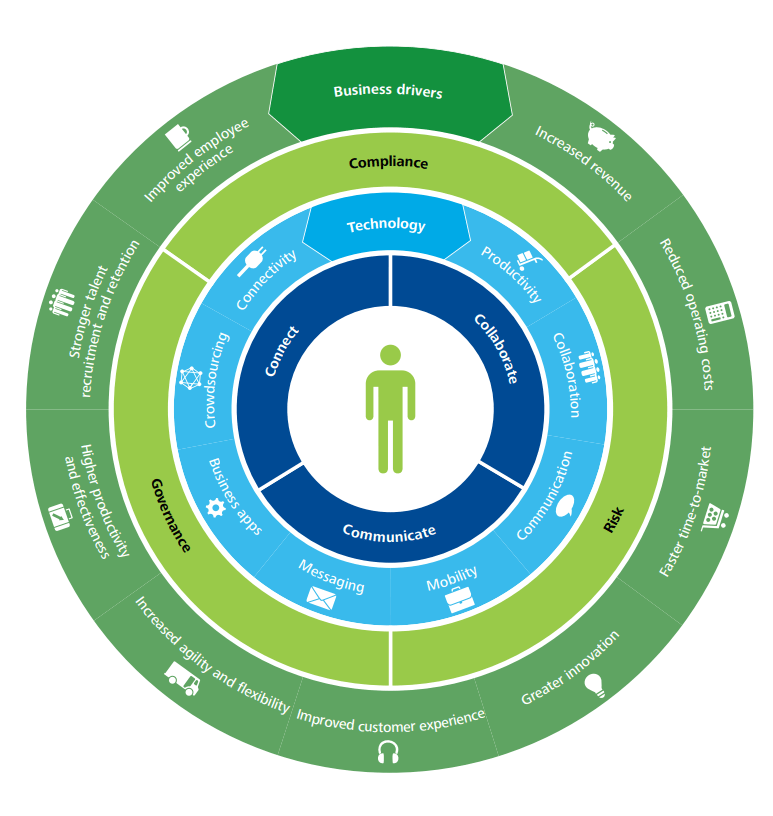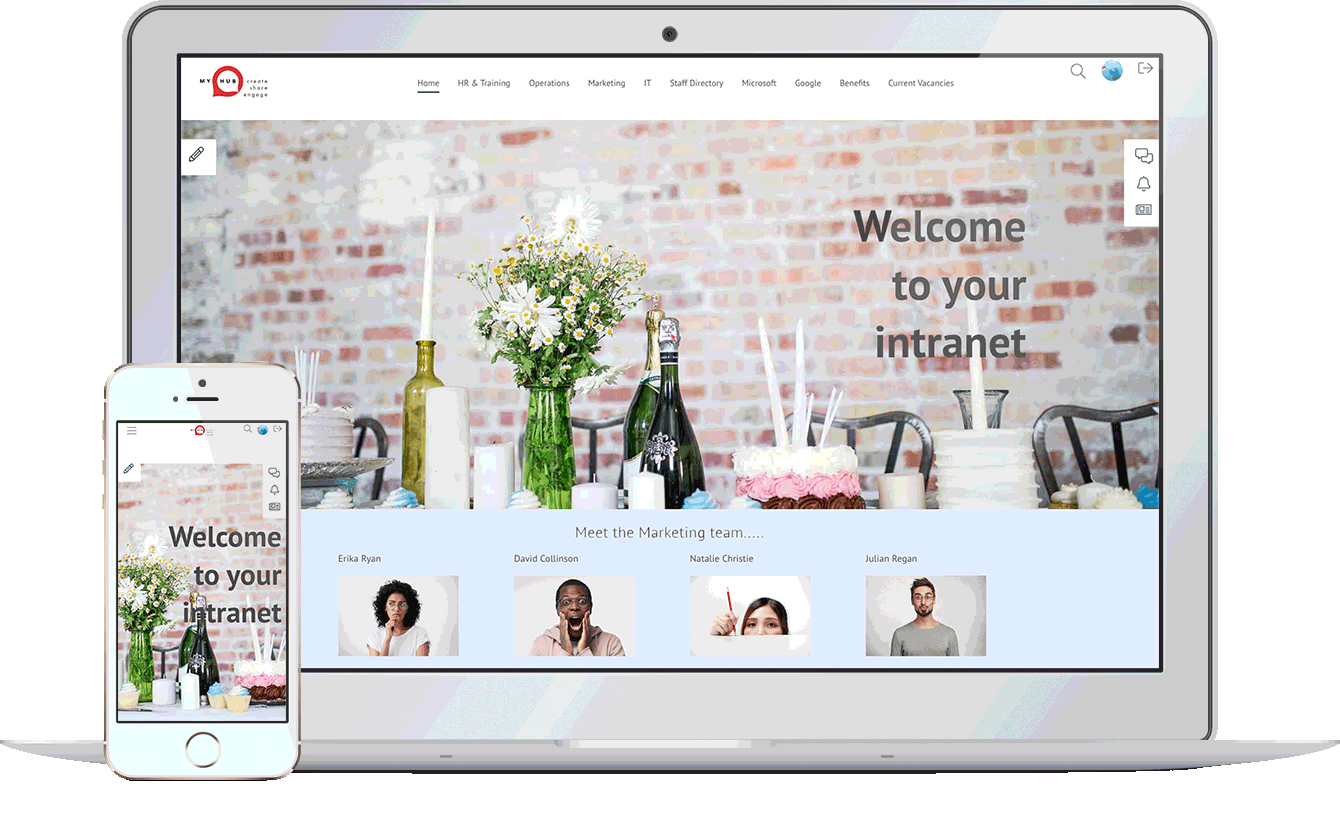Digital Workplace
Enable remote working for staff and let technology, people and processes unite
Share. Engage. Connect

Today’s always-connected, instant-access working environment has questioned the need for office-based working. Like never before, staff are connecting and collaborating with their peers in real-time, from any location.
As more staff transition to a work-from-home scenario, digital workplace technology offers a vital agile setting for businesses. Digital workplace technology can improve productivity, creative thinking, and team collaboration.
While some organizations have already embraced a digital workplace culture, others are being forced unexpectedly into managing staff remotely. The silver lining for the latter cohort is that if done right, remote working can facilitate a smarter, faster, better operation. Businesses stand to benefit from increased employee engagement and all-round improved business performance.
What is the Digital Workplace?

One of the most accepted definitions of the digital workplace is “the alignment of technology, employees and business processes to improve operational efficiency and meet organizational goals”.
Gartner describes it as a way of enabling new, more effective ways of working; raising employee engagement and agility; and exploiting consumer-oriented styles and technologies.
It’s been dubbed as the fourth industrial revolution, the digital transformation.
New digital workplace practices are being embedded into everyday life, across every size and type of business. Artificial intelligence, automation, and machine learning technology are taking over manufacturing, service work, and many other essential business tasks. And while most companies acknowledge the benefits of digital working, many admit to lacking the technical knowledge to lead the way (source: McKinsey & Company).
Distributed Working: The New Normal

The way in which we spark ideas and get work done has changed forever. With more employers supporting the distributed workforce model – either through choice or an unexpected crisis – the practical side of completing tasks and communicating with colleagues now, more-often-than-not, takes place in a digital space. Indeed, many economists forecast the physical office will soon be a thing of the past, accelerated by the recent Covid-19 pandemic.
A distributed workforce – also known as remote workers, digital nomads, telecommuters or home office workers – work from any location, across multiple devices. They value work/life balance, flexible hours – and critically, the need to feel connected. Digital workplace technology provides this essential connection – emphasizing the importance of friction-free, easy-to-use software.
If the physical office is no longer a place we go to work, these digital touchpoints play a vital role in how employees stay motivated, informed and engaged in what they do.
The onus will be on the employer to optimize the digital workplace experience for employees. Security, fast access, as well as intuitive and compatible software are just some of the important considerations when transitioning into a digital world.
Key Benefits Of A Digital Workplace Strategy
The advantages of adopting a digital workplace strategy spread wider than most businesses originally anticipate. Here are some of the expected and unexpected benefits:
Team Collaboration
Improved levels of problem-solving, interaction and knowledge-sharing – all-round improved collaboration
Flexible Remote Working
Allows employees to work from home, supporting more flexible working
Productivity Boost
Increased efficiency and employee productivity through improved communications
Innovation
Great ideas can come from anywhere – not just the boardroom – if staff have the right channels
Change Management
Clear, reliable communications minimizes confusion and garners internal support
Improved Transparency
Improved traceability and transparency amongst teams, reducing errors
Hidden Savings
Decreased employee commuting expenses and business real estate cost
Employee Experience
Improved personal experiences through greater inclusivity and integration of tasks
Retain Talent
Lower employer turnover rates due to improved work/life balance and engagement
The Digital Workplace Framework
Deloitte has developed a four-layer framework to help govern the design of a digital workplace. This is a useful guide for those businesses looking for workplace transformation. This framework comprises of:
1) Use – for staff to collaborate, communicate and connect
2) Technology – the digital tools to enable staff to do their job
3) Control – having the right governance structure and compliance controls in place to reduce risk
4) Business drivers – measuring the outcomes and actual business value.
It explains how to leverage your investment to support a new and better way of doing business that will enhance both the employee experience and the customer experience.

Tips For Deploying A Digital Workplace
Here are some practical tips to help you blend your existing applications with new technology to create the ultimate user experience and a high-performing work environment.
1. Involve the right people to steer the project. Senior ownership is vital, but including representatives who will drive the technology is also key.
2. Ensure alignment with business strategy. Keep your big picture always in mind i.e. ‘will this new tool and process-change enable us to achieve our goals?’
3. Consider internal culture. How amenable will staff be to new technology and digital experiences? Develop an internal communications program to explain the benefits of digital technology and how vital it is in today’s workplace. And most of all, make it easy for staff to do their job.
4. Deliver business value. Avoid falling for the ‘shiny new thing’. Stay true to the original outcomes your business needs.
5. Research technologies. A good case study, a free trial, a call with a current user – these are all helpful ways to shortlist new technologies. There are multiple service providers playing in a very dynamic, competitive digital market.
6. Consider risk, compliance and legal consequences. There are important regulations surrounding data management and security that must be adhered.
Digital Workplace: Future Trends
What are the anticipated trends at play when today’s graduates become tomorrow’s C-suite, artificial intelligence is mainstream, and the traditional office is no more?
Here’s our view of the future and the role of the digital workplace:
Cloud-based Solutions
Effective, cloud services with unlimited access will be essential to support remote working
No Standing Still
Technology will continue to evolve, either organically or intentionally. Status quo is not an option
All-On Automation
Traditional ways of working will continue to be disrupted; automated processes will increase
Tech Choice Matters
Technology stack choices will become more important when attracting staff and tech compatibility
Staff Expectations
Young workers have a huge appetite for social tools and tech, increasing pressure for employers to invest
Customer Self-Service
Customers will want to search and solve their own questions independently, without speaking with an agent
Overwhelming Options
Choice-explosion of SaaS products could be overwhelming; apps may fail to work together
Employee Experience
Employers will try harder to motivate, engage, inspire and involve staff to retain talent
Tech Maze
Employees become ‘trapped in the tech maze’ with many apps overlapping and staff feeling bamboozled
❝
The Digital Workplace is a work in progress, an ongoing journey, with only 14% of companies believing they are at a ‘mature phase’.
Source: Digital Workplace Group
Digital Workplace Software
Core to the successful adoption of a digital attitude is finding ways to support staff as they navigate through the tech maze of the modern digital workplace, along with adjusting to working from home. While there are countless business apps and platforms suited to their specific areas of business, a central hub – or gateway if you like – where staff can access everything they need to complete their job is vital.
MyHub intranet software provides that central digital space for staff to communicate, share and source company information, regardless of their location. Our cloud-hosted, single access point makes life easier for staff, helping them do their job better.
From instant messaging to the seamless integration of business applications, workflow automation to access-controlled content libraries, MyHub brings together all this into a beautifully-sleek, easy-to-navigate digital workplace. All accessible with a single sign-on.
Digital Workplace Tools: The MyHub Difference

Considered the central hub of your digital workplace solution, MyHub is fully scalable, designed to support your company’s growth. And fully customizable, to meet your exact needs.
Designed with the non-technical buyer in mind, MyHub requires no coding skills or IT experience. It is simple to set-up – and fun to use!
Using simple drag-and-drop functionality, you can create a professional digital workspace in minutes! Being cloud-hosted also means you’re future-proofing your investment: you get to benefit from our latest new features and enhancements as soon as they’re released.
Let our technology unleash a smarter and super-efficient digital workplace solution that your staff will love.
❝
Managers have reduced the time spent on management activities by one to three hours due to system integration and collaboration tools
Useful Digital Workplace Resources
Top 10 HR Networking Groups for Professionals
Human Resources (HR) networking groups are essential platforms that help professionals stay informed and connected in an ever-evolving industry. These communities provide valuable opportunities for peer support, continuous learning, and professional growth. Whether you are a seasoned HR expert or new to the field, joining the right HR network can offer access to cutting-edge insights, practical resources, and career development opportunities.
This blog post highlights the top 10 HR networking groups that every professional should consider. From large organizations like the Society for Human Resource Management (SHRM) and HR.com to niche communities such as the National Association of African Americans in Human Resources (NAAAHR), these networks offer a variety of resources, certifications, and events designed to enhance your HR skills. Many groups provide free memberships or affordable plans, ensuring access for professionals at all career stages.
Ultimately, active participation in HR networks allows professionals to navigate complex workplace challenges, share innovative ideas, and grow their careers. While membership fees and time commitment can be considerations, the benefits of networking—such as gaining peer insights, exploring new HR technologies, and advancing professional development—make these communities invaluable. Choosing the right networks aligned with your goals is key to maximizing their value.
11 Employee Needs Work Should Satisfy
Employees are the backbone of every successful organization, and meeting their workplace needs is crucial for fostering motivation, engagement, and retention. This blog post identifies 11 essential needs that work must satisfy — ranging from fair pay and job security to mental wellbeing and a sense of purpose. Addressing these needs helps create a positive culture where employees feel valued and supported.
The post explores how fundamental human needs, like safety, belonging, recognition, and growth, translate directly into workplace expectations. It highlights practical ways employers can support staff, such as providing secure working conditions, investing in professional development, and promoting work-life balance. These efforts not only improve employee satisfaction but also lead to tangible business benefits, including increased productivity and lower turnover.
By aligning employee needs with company goals, organizations can build a thriving, people-centered workplace. The article also ties these concepts back to Maslow’s hierarchy of needs, demonstrating how basic human motivations remain relevant in modern work environments. Ultimately, prioritizing employee needs is a strategic investment in long-term business success.
Is An Enterprise Social Network Right For Your Business?
In today’s hybrid work environments, traditional communication methods often fall short in fostering effective collaboration. Enterprise Social Networks (ESNs) offer a solution by providing a secure, internal platform for employees to connect, share information, and collaborate in real-time. These platforms combine elements from popular social media sites, such as messaging, content sharing, and community building, tailored specifically for organizational use.
The blog post delves into the advantages of adopting an ESN, including improved internal communication, enhanced knowledge sharing, and the ability to break down departmental silos. By centralizing communication and collaboration tools, ESNs enable employees to access information and engage with colleagues more efficiently, regardless of their location. This leads to faster decision-making, increased productivity, and a more cohesive organizational culture.
However, the implementation of an ESN is not without challenges. The article also addresses potential drawbacks, such as the risk of information overload, the need for proper training, and the importance of establishing clear guidelines to ensure the platform is used effectively. By weighing these factors, organizations can make informed decisions about whether an ESN aligns with their communication and collaboration needs.
10 Ways To Build A Strong Work Community
A strong workplace community is essential for employee engagement and organizational success. It goes beyond company culture, focusing on creating a shared sense of purpose and mutual trust among employees. Such communities are characterized by open communication, collaboration, and a supportive environment where team members feel valued and connected.
The blog outlines ten practical and cost-effective strategies to build a robust work community. These include prioritizing effective onboarding to ensure new hires feel welcomed, encouraging open communication to foster transparency, and celebrating achievements to recognize contributions. Additionally, establishing regular team rituals and providing opportunities for social interactions can strengthen bonds among colleagues.
Implementing these strategies can lead to increased productivity, reduced turnover, and a more positive work environment. By focusing on building relationships and trust, organizations can create a workplace where employees are motivated, engaged, and committed to shared goals.
Destructive Criticism at Work: Examples and How to Deal With It
Criticism is an integral part of professional development, but not all feedback is beneficial. Constructive criticism aims to guide and improve performance, offering specific, actionable suggestions delivered respectfully. In contrast, destructive criticism is harmful, often manifesting as personal attacks or vague, non-specific comments that undermine confidence and morale.
The blog post emphasizes the importance of recognizing the signs of destructive criticism, such as a focus on personal attributes rather than actions, a lack of helpful suggestions, and a tone that is more accusatory than supportive. It highlights the detrimental effects this type of feedback can have on individuals and teams, including decreased morale, increased conflict, and hindered collaboration.
To address destructive criticism, the article provides practical strategies for both recipients and deliverers of feedback. These include fostering a culture of open communication, setting clear expectations for feedback delivery, and implementing training programs to enhance emotional intelligence and constructive communication skills within teams.
Poor Leadership: 10 Tell-Signs And Tips On How To Cope
Poor leadership can have detrimental effects on both individuals and organizations, leading to low morale, high turnover, and decreased productivity. Recognizing the signs of ineffective leadership is the first step toward addressing these issues.
The blog post outlines ten tell-tale signs of bad leadership, including poor communication, lack of recognition, micromanagement, and a “my way or the highway” mentality. These behaviors can create a toxic work environment and hinder team collaboration.
To mitigate the impact of poor leadership, the article offers practical tips such as fostering open communication, setting clear expectations, and promoting a culture of appreciation. By implementing these strategies, organizations can work towards creating a more positive and productive workplace.






